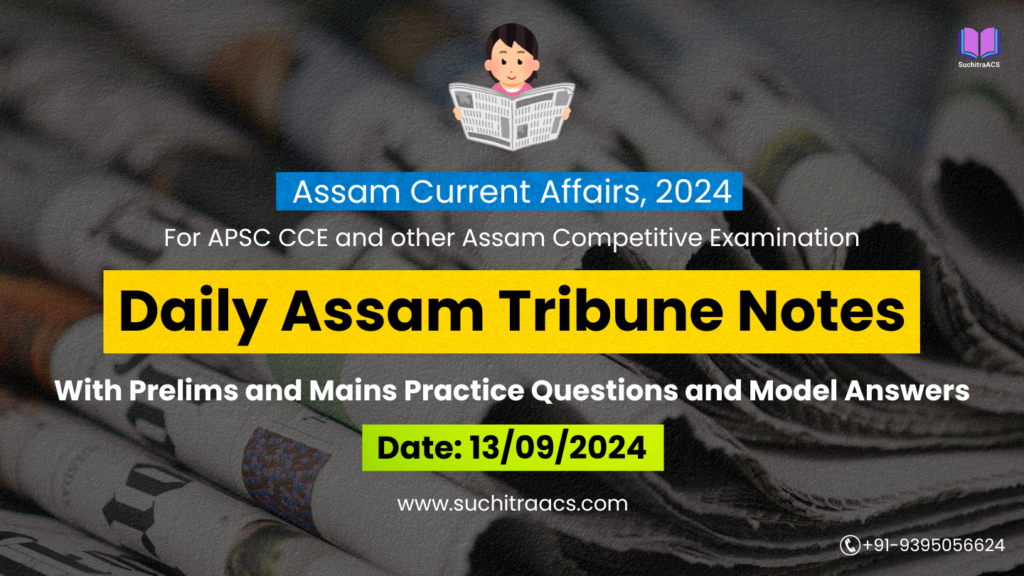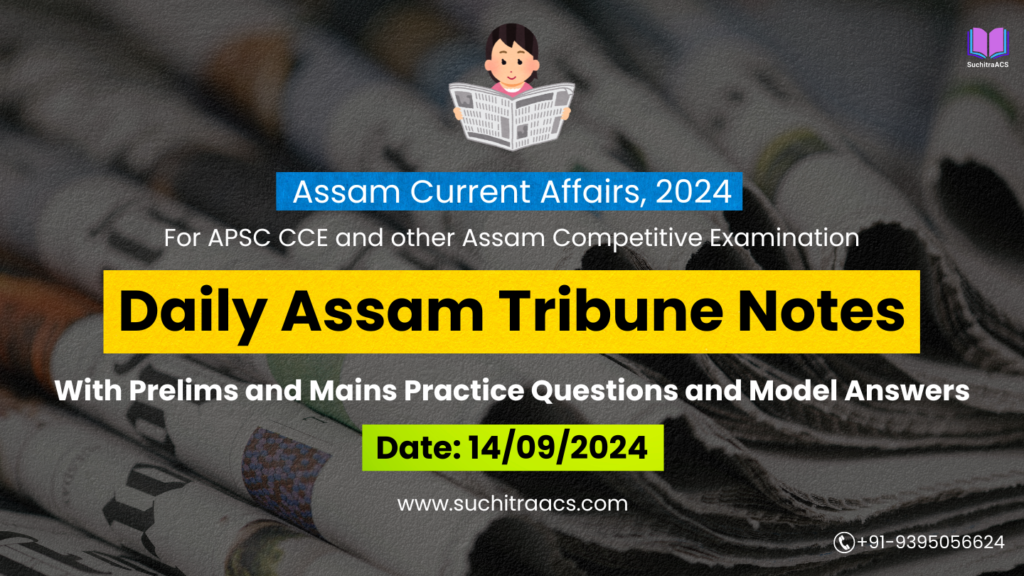APSC Current Affairs: Assam Tribune Notes with MCQs and Answer Writing (11/06/2025)
For APSC CCE and other Assam Competitive examinations aspirants, staying updated with current affairs is vital. This blog covers most important topics from the Assam Tribune today (11-06-2025). These issues are key for both APSC Prelims and Mains preparation, offering insights into the APSC CCE Syllabus.
✨ APSC CCE Online Coaching, 2026

👩⚕️ Assam Cabinet Hikes Incentives for ASHA Workers: Empowering Frontline Healthcare
📘 GS Paper 2: Welfare Schemes | Health Governance | Centre-State Relations
📘 GS Paper 5 (APSC): Assam – Public Health | Women Empowerment | State Administration
🔹 Introduction
The Assam Cabinet on 10 June 2025 approved an increase in monthly honorarium for ASHA (Accredited Social Health Activist) workers and supervisors. The move is a long-pending demand aimed at recognising their critical role in public healthcare delivery, especially in rural and under-served areas. This decision marks a crucial step in improving the status of women community health workers under the National Rural Health Mission (NRHM) framework.
🔑 Key Updates
| Feature | Previous Amount | Revised Amount (from Oct 1, 2025) | Share – Central: State |
| ASHA Worker Honorarium | ₹3,000/month | ₹4,000/month | ₹2,500 : ₹1,500 |
| ASHA Supervisor Honorarium | ₹9,000/month | ₹10,200/month | ₹7,500 : ₹2,700 |
Over 30,000 ASHA workers and supervisors in Assam will benefit from the hike.
Assam’s initiative aligns with broader national objectives to formalise and incentivise frontline healthcare work.
🧠 Prelims Pointers
ASHA Programme: Launched in 2005 under NRHM; ASHAs are community health volunteers (not permanent staff).
Key Roles: Maternal-child health promotion, immunisation drives, family planning, tuberculosis & malaria tracking.
Selection Criteria: ASHAs are women from the local community, typically educated up to Class VIII/X.
Pay Structure: Fixed honorarium + performance-based incentives (e.g., ₹300 for institutional delivery support).
Recent National Update: Govt. of India has proposed including ASHAs under social security and insurance schemes.
📝 Mains Pointers
A. Importance of ASHAs in Healthcare
| Area | Contribution |
| Public Health | Key link between community and Primary Health Centres (PHCs) |
| Pandemic Response | Played a critical role during COVID-19 for contact tracing, awareness, and vaccination |
| Women Empowerment | Over 95% ASHAs are rural women—empowered with training and stipends |
| Preventive Care | Promotes hygiene, nutrition, institutional births, child immunisation |
B. Challenges Faced by ASHA Workers
| Challenge | Explanation |
| Low Compensation | Many earn less than ₹6,000/month despite 24×7 field duties |
| Job Insecurity | Contractual status; no fixed employment or pension benefits |
| Gender Exploitation | Face workplace harassment and under-recognition |
| Training & Infrastructure | Inadequate refresher training and digital tools for reporting |
C. Assam-Specific Context
Geographical Spread: Many ASHAs cover hard-to-reach areas (e.g., char-chapori, tea garden zones).
TB & Maternal Mortality Rates: Heavily reliant on ASHA support in improving indicators.
State Innovations: Use of mobile health apps, telemedicine, and ASHA performance dashboards.
D. Way Forward
🧾 Regularisation of Pay & Benefits: Move towards minimum wage norms and pension eligibility
📱 Digital Literacy Programs: Equip ASHAs with tablets and training for real-time data entry
🎓 Career Pathways: Enable promotion to ANMs (Auxiliary Nurse Midwives) and health educators
🧠 Grievance Redressal: Strengthen mechanisms to report harassment or non-payment
💬 Social Recognition: Annual state-level awards and insurance cover under PM Suraksha Bima Yojana
📑 Relevant Reports & Policies
National Health Policy, 2017 – recognises ASHAs as essential public health workforce
Lancet Report on Indian Health Workforce, 2022 – ASHAs vital for bridging last-mile delivery
Assam Health Vision 2030 – Includes workforce strengthening, maternal-child health targets
CAG Audit on NHM (2020) – Recommends better ASHA incentive monitoring
🧩 Conclusion
The Cabinet’s decision to increase ASHA honorarium is not merely a fiscal adjustment—it is an acknowledgement of grassroots health warriors who hold India’s rural health system together. For Assam, this could strengthen public health outcomes and set a precedent for more gender-inclusive and decentralised health governance.
🌧️ Urban Flooding in Assam: Causes, Impacts & Mitigation Strategies
📘 GS Paper 3: Disaster Management | Environment | Urbanization
📘 GS Paper 1: Geography – Hydrological Hazards
📘 GS Paper 5 (APSC): Assam – Urban Governance | Waterlogging | Local Administration
🔹 Introduction
Heavy pre-monsoon rainfall on 10 June 2025 triggered severe urban flooding in Guwahati and parts of Silchar, causing massive traffic snarls, damage to low-lying areas, and power outages. The recurring waterlogging during seasonal showers has raised critical concerns over urban drainage, land use planning, and climate resilience in Assam’s growing cities.
🔑 Key Highlights
| Area Affected | Specific Issues Reported |
| Guwahati (GS Road, Zoo Road, Paltan Bazar) | Knee-deep water, traffic blockades, overflowing drains |
| Silchar City | Flooding near Sonai Road and College areas due to poor water exit points |
| Key Triggers | Heavy rainfall + clogged drains + concretisation + encroachment of wetlands |
| Urban Response Issues | Absence of real-time flood alerts, poor coordination between GMDA, GMC, APDCL |
🧠 Prelims Pointers
Urban Flooding: Different from riverine floods; caused by rainfall + poor drainage
Guwahati Smart City Mission: Includes integrated drainage planning but limited progress
Brahmaputra Valley’s Topography: Susceptible to flash floods due to high runoff and siltation
Deepor Beel Wetland: Guwahati’s natural stormwater sink – now degraded and encroached
Assam Urban Infrastructure Investment Programme (AUIIP): ADB-supported initiative for drainage upgrade
📝 Mains Pointers
A. Causes of Urban Flooding in Assam Cities
| Cause | Explanation |
| Inadequate Drainage | Old narrow drains, encroached nullahs, poor maintenance |
| Wetland Loss | Deepor Beel, Silsako Beel filled for construction, losing water retention zones |
| High-Intensity Rainfall | Climate change has increased pre-monsoon rain intensity |
| Unplanned Urbanization | Buildings over stormwater channels without mapping or EIA |
| Lack of Coordination | Multiple agencies (GMC, GMDA, WR Dept) with overlapping jurisdictions |
B. Consequences
Health risks due to contaminated water and mosquito-borne diseases
Damage to vehicles, shops, homes, and urban public infrastructure
Disruption of school, hospital, and emergency services
Loss in productivity and urban economy slowdown
Erosion of public trust in civic planning and disaster readiness
C. Existing Measures in Assam
Guwahati Drainage Master Plan (Revised 2022) – delayed execution
ADB-funded flood-proofing in Silchar, Dibrugarh under AUIIP
Deployment of mobile dewatering pumps by Disaster Management Authority
Early Warning Systems in collaboration with IMD (pilot phase)
Swachh Bharat Urban drainage-cleaning campaigns launched before monsoons
D. Way Forward
🏗️ Adopt Sponge City principles – create absorbent pavements, rooftop water harvesting
📱 Launch urban flood risk dashboards using GIS and IoT sensors
🗺️ Map and restore urban wetlands and stormwater channels under a legal mandate
🧑💼 Strengthen inter-agency coordination with a single disaster cell per city
🌧️ Develop urban resilience plans under SAPCC (State Action Plan on Climate Change)
📑 Relevant Reports & Frameworks
National Disaster Management Guidelines (Urban Flooding – NDMA, 2010)
AMRUT 2.0 – Targets urban infrastructure resilience
Assam SAPCC (Updated 2021) – Lists urban flooding as climate stressor
National Wetland Atlas – Maps urban beels, many of which are vanishing
UN-Habitat & NITI Aayog Reports on Urban Resilience (2023)
🧩 Conclusion
Urban flooding is not merely a natural phenomenon but a consequence of flawed planning and weak urban governance. Assam’s cities, led by Guwahati, must shift toward a sustainable urban hydrology model, integrating traditional water wisdom, modern drainage systems, and community preparedness.
🛕 Satra Land Commission Submits Report: Resolving Land Rights of Assam’s Religious Institutions
📘 GS Paper 2: Governance | Land Reforms | Rights of Religious Institutions
📘 GS Paper 1: Indian Culture – Institutions & Regional History
📘 GS Paper 5 (APSC): Assam – Heritage Conservation | Administrative Reforms | Land Laws
🔹 Introduction
The Satra Land Commission, formed by the Assam Government in 2022, submitted its final report to the Chief Minister on 10 June 2025. The report outlines the status of land holdings, encroachments, and legal claims of various Sattras (Vaishnavite monasteries) across Assam. This initiative seeks to safeguard religious heritage and traditional rights, while also addressing land conflict, illegal occupation, and revenue clarity.
🔑 Key Highlights
| Feature | Details |
| Commission Formed | 2022 – under Assam Government notification |
| Purpose | Assess land allotted, occupied, or encroached at different Sattras |
| Institutions Covered | Over 830 Sattras, mostly in Majuli, Nagaon, Barpeta, Kamrup, and Nalbari |
| Findings (Unofficial) | Over 12,000 bighas of land reportedly encroached across 300+ Sattras |
| Recommendations | Digital land mapping, eviction of non-bona fide encroachments, legal titles |
| Legal Framework Referenced | Assam Land and Revenue Regulation, 1886 |
🧠 Prelims Pointers
Sattras: Monastic institutions of Ekasarana Dharma established by Srimanta Sankardeva
Key Sattras: Auniati, Dakhinpat, Kamalabari (Majuli); Barpeta Satra; Uttar Kamalabari
Majuli: World’s largest river island; cultural hub of Vaishnavite Sattras
Land Record Digitization in Assam: e-Panjeeyan, Dharitree, e-Pattadar projects underway
Encroachment Drives: Recent high-profile ones include Batadrava, Sipajhar, and Dhalpur
📝 Mains Pointers
A. Significance of the Commission
Upholds traditional rights of religious and cultural institutions
Helps resolve land title ambiguity and prevent political misuse of Satra lands
Strengthens heritage preservation amid growing urbanisation
Acts as a model for managing temple/monastery land disputes in other states
Encourages record-keeping and public accountability in religious trusts
B. Major Issues Identified
| Problem Area | Description |
| Encroachments | Illegal settlements on Sattra land, often in buffer or pasture zones |
| Lack of Mutation | Many Sattras have not updated or digitised their ownership records |
| Boundary Disputes | Conflicts between Sattras and nearby villagers over unclear demarcations |
| Revenue Loss | Non-commercial use of Satra land not properly recorded in govt. revenue books |
| Identity & Security Concerns | Political tension over encroachment by migrants or communal narratives |
C. Government & Administrative Measures
Land Revenue Dept instructed to fast-track digital mapping of religious lands
Eviction drives conducted in Kamrup, Barpeta, and Nagaon based on interim findings
Inclusion of Satra land protection clauses in new land tenancy and ceiling laws
Plans to set up a dedicated grievance cell for affected Sattras and public complaints
Geo-fencing of institutional land to prevent future encroachment
D. Way Forward
🗺️ Complete GIS-based cadastral mapping and share data with local Sattras
📜 Provide title regularisation where institutions have undocumented historic rights
⚖️ Ensure due legal process and community dialogue before any eviction
🏛️ Bring Satra administration under a non-political regulatory board for land governance
🧑💼 Train land officers in heritage-sensitive governance, especially in Majuli and Barpeta
📑 Relevant Reports & Frameworks
Assam Land Revenue Regulation, 1886 (with amendments)
Assam Land Ceiling Act, 1976
National Land Records Modernization Programme (NLRMP)
Majuli Cultural Landscape Conservation Plan (proposed)
UNESCO Guidelines for Cultural Landscapes – relevant for heritage land zoning
🧩 Conclusion
The submission of the Satra Land Commission report offers an opportunity for Assam to harmonize cultural heritage with modern governance. Protecting Sattras isn’t merely a matter of religion—it is about safeguarding the living cultural history of Assam. Ensuring fair land rights, administrative accountability, and public transparency can transform this initiative into a model for inclusive, heritage-aligned land policy.
🌐 Gelephu SEZ Vision: Bhutan’s Mega Smart City Near Assam Border
📘 GS Paper 2: International Relations | India and Neighbourhood
📘 GS Paper 3: Infrastructure | Border Area Development | Regional Cooperation
📘 GS Paper 5 (APSC): Assam – Trade Connectivity | North-East & Neighbourhood | Act East Policy
🔹 Introduction
Bhutan’s Gelephu region, located close to the Assam border (Chirang district), is being developed into a “Mindfulness City” Special Economic Zone (SEZ). The proposed project includes urban wellness infrastructure, green technology parks, and cross-border connectivity corridors, with potential spillover impacts on Assam’s economy, infrastructure, and diplomacy.
🔑 Key Highlights
| Feature | Details |
| Project Location | Gelephu, Sarpang District, Bhutan – near Bhutan-Assam border |
| Vision | A Buddhist-inspired “Mindfulness City” with green SEZ, wellness hubs |
| Developer | Royal Government of Bhutan, with Singaporean and European partnerships |
| Connectivity Potential | Link via Samdrup Jongkhar – Gelephu – Bongaigaon corridor |
| India’s Role | Possible trade partner, transit facilitator, and development collaborator |
| Geopolitical Interest | Counters Chinese infrastructure activity near Bhutan’s southern flank |
🧠 Prelims Pointers
Gelephu SEZ: Flagship Bhutanese initiative launched in 2024
Act East Policy: India’s strategy to enhance connectivity with ASEAN via NE India
India-Bhutan Border: 699 km long; key crossings at Samdrup Jongkhar (Assam) and Phuentsholing (West Bengal)
BBIN Initiative: Bangladesh-Bhutan-India-Nepal Motor Vehicle Agreement – Bhutan opted out but may re-engage
North East Frontier Rail Projects: Extend Indian connectivity to Bhutan and Arunachal sectors
📝 Mains Pointers
A. Strategic Importance for Assam & NE
| Domain | Impact |
| Border Trade | Gateway to Bhutanese goods & services (handicrafts, wellness, organics) |
| Tourism | Spiritual and wellness tourism corridor between Assam and Bhutan |
| Infrastructure Boost | Bongaigaon, Chirang may see upgrades in roads, border trade centres |
| Cultural Diplomacy | Shared Buddhist and tribal linkages can foster people-to-people ties |
| Geopolitical Counterbalance | Reinforces India’s soft presence in Bhutan amid China’s interest |
B. Challenges and Caution Points
| Challenge | Explanation |
| Security Risks | Open trade may increase vulnerability to trafficking or illegal trade |
| Infrastructure Readiness | Assam’s road and border logistics still underdeveloped (e.g., NH-127B) |
| Regulatory Coordination | Bhutanese SEZ laws and Indian customs protocols need harmonization |
| Environmental Fragility | Himalayan foothills prone to landslides, ecological disruption |
| Diplomatic Sensitivity | Bhutan’s cautious approach to foreign investments must be respected |
C. India’s Opportunities & Strategic Role
Offer technical expertise, digital infra, and green energy collaboration
Integrate AIDC (Assam Industrial Development Corporation) into joint ventures
Boost Act East connectivity through:
Samdrup Jongkhar–Tawang–Tezpur route
India-Bhutan rail connectivity (Kokrajhar–Gelephu feasibility studies)
Coordinate through MEA and North Eastern Council (NEC) for regional synergy
Promote border haats and logistics hubs in Chirang and Bongaigaon
D. Way Forward
🚉 Accelerate multi-modal logistics projects in lower Assam border zones
🧭 Establish Assam–Bhutan Business Cooperation Cell under AIDC/Industries Dept
🌿 Design eco-sensitive trade protocols aligned with Bhutan’s environmental values
🤝 Organize cross-border cultural exchanges – music, meditation, heritage festivals
📊 Draft a Border Economic Zone (BEZ) Strategy Paper with stakeholder input
📑 Relevant Frameworks & Agreements
India-Bhutan Friendship Treaty (2007)
BBIN MVA (2015) – stalled, but may revive with Bhutan’s cooperation
North East Border Trade Policy (Draft) – envisions border logistics infrastructure
ASEAN-India Connectivity Report (2024)
UNESCAP’s Trans-Himalayan Corridor Strategy
🧩 Conclusion
The Gelephu SEZ is not just Bhutan’s dream—it is an opportunity for Assam to redefine itself as a gateway to the Eastern Himalayas. With visionary infrastructure planning, diplomatic maturity, and cultural alignment, this project could serve as a model of spiritual, sustainable, and cross-border regional development.
APSC Prelims Practice Questions
✅ Topic 1: ASHA Honorarium Hike
1. Which of the following statements about ASHA workers is/are correct?
- ASHA workers are salaried employees of the Ministry of Health and Family Welfare.
- They were introduced under the National Rural Health Mission.
- ASHA workers are eligible for fixed honorarium and performance-based incentives.
Choose the correct answer:
A. 1 and 2 only
B. 2 and 3 only ✅
C. 1 and 3 only
D. All of the above
🧠 Explanation:
- Statement 1 is incorrect: ASHAs are volunteers, not salaried staff.
- Statement 2 is correct: Introduced in 2005 under NRHM.
- Statement 3 is correct: They receive both a fixed honorarium and task-based incentives.
✅ Topic 2: Urban Flooding in Guwahati
2. Which of the following best explains “urban flooding”?
A. Overflow of rivers in rural areas
B. Flooding due to melting glaciers
C. Waterlogging in urban areas caused by intense rainfall and poor drainage ✅
D. Submergence due to tsunami impact
🧠 Explanation:
Urban flooding occurs in built-up areas where rainwater has no natural escape routes due to encroachments, clogged drains, and unplanned construction.
3. Deepor Beel, often in news due to flooding, is:
A. A man-made lake
B. A Ramsar site and natural stormwater sink in Guwahati ✅
C. A thermal power station in Assam
D. A river originating from the Himalayas
🧠 Explanation:
Deepor Beel is a Ramsar wetland and the natural flood buffer for Guwahati. Its encroachment has worsened flooding.
✅ Topic 3: Satra Land Commission Report
4. The term Satra, in the context of Assam, refers to:
A. A tribal village council
B. A Vaishnavite monastic institution established by Srimanta Sankardeva ✅
C. A community forest
D. A historical irrigation system
🧠 Explanation:
Sattras are monasteries and socio-religious centres of Ekasarana Dharma founded in the 15th–16th centuries.
5. The Assam Land and Revenue Regulation of 1886 primarily deals with:
A. Forest conservation
B. State boundary demarcation
C. Land allotment, tenancy, and mutation laws in Assam ✅
D. Urban planning schemes
🧠 Explanation:
The Assam Land and Revenue Regulation, 1886 governs land ownership, tenancy, and revenue administration.
✅ Topic 4: Gelephu SEZ and India-Bhutan Connectivity
6. Consider the following about Bhutan’s Gelephu Smart SEZ:
- It is located near the Assam-Bhutan border in Sarpang district.
- It is being developed under the “Act East” initiative of the Indian government.
- It envisions a spiritual, green city model aligned with Bhutan’s Gross National Happiness.
Which of the above is/are correct?
A. 1 and 3 only ✅
B. 2 and 3 only
C. 1 and 2 only
D. All of the above
🧠 Explanation:
- Statement 1: Correct – Gelephu lies close to Assam’s Chirang district.
- Statement 2: Incorrect – The SEZ is Bhutan-led; India may collaborate under Act East, but it is not Indian-initiated.
- Statement 3: Correct – The project is aligned with Bhutan’s mindfulness and green development goals.
7. The BBIN Motor Vehicles Agreement includes which of the following countries?
- Bhutan
- Bangladesh
- India
- Nepal
Select the correct code:
A. 1 and 3 only
B. 2, 3 and 4 only
C. 1, 2, 3 and 4 ✅
D. 2 and 4 only
🧠 Explanation:
The BBIN MVA was signed by all four countries in 2015. Bhutan later paused ratification, but all four were involved.
APSC Mains Practice Question
📝 Mains Question:
Q. Discuss the role of ASHA workers in strengthening India’s rural health system. Critically examine the challenges they face and suggest reforms needed to ensure dignity, effectiveness, and sustainability in their service.
📘 Model Answer
Introduction
ASHAs or Accredited Social Health Activists were introduced in 2005 under the National Rural Health Mission (NRHM) to act as a bridge between the community and the public health system. With over 10 lakh ASHA workers nationwide, they form the backbone of India’s grassroots healthcare, particularly in rural and remote areas. In Assam, over 30,000 ASHAs operate in flood-prone, tea garden, and tribal regions, often in challenging environments.
Role of ASHAs in Rural Health
| Domain | Contribution |
| Maternal & Child Health | Promoting institutional deliveries, immunizations, and antenatal care |
| Disease Surveillance | Identifying TB, malaria, and leprosy cases; contact tracing (esp. during COVID-19) |
| Health Education | Spreading awareness about hygiene, nutrition, contraception |
| Referral Services | Escorting patients to PHCs, guiding families on treatment protocols |
| Community Mobilization | Facilitating village health days, coordinating SHGs, and acting as first responders |
Challenges Faced by ASHA Workers
| Challenge | Description |
| Low Honorarium | Many ASHAs earn < ₹6,000/month, despite 24×7 availability and rising responsibilities |
| Insecure Employment | They are not formally employed or covered under labour laws |
| Delayed Payments | Incentives are often delayed due to procedural bottlenecks |
| Lack of Recognition | Despite major roles during COVID-19, their work remains undervalued |
| Limited Career Growth | No upward mobility into ANM, nursing, or supervisory roles |
| Digital Divide | Struggles with mobile-based health apps and reporting systems |
Reform Measures & Assam Context
Recently, the Assam Cabinet (June 2025) increased the monthly honorarium for ASHA workers from ₹3,000 to ₹4,000 and supervisors from ₹9,000 to ₹10,200, showing a move toward recognition and welfare.
Suggested National-Level Reforms:
- Minimum Wage Guarantee – Link honorarium to State minimum wages
- Social Security Net – Provide access to pension (PM Shram Yogi Maan Dhan), life and health insurance
- Skill Upgradation – Offer ASHAs certified training for promotion to ANM or health educators
- Digital Empowerment – Provide mobile devices, data plans, and ICT training
- Grievance Redressal Mechanism – Helplines and legal aid for workplace harassment or non-payment
Conclusion
ASHA workers are unsung heroes of India’s health mission, especially in underserved and disaster-prone areas like Assam. To ensure that they continue to serve with dedication and dignity, India must move from symbolic appreciation to systemic integration. Recognizing them as an essential workforce with proper remuneration, security, and respect is crucial for building a resilient, inclusive, and equitable rural health system.
✨ APSC CCE Courses, 2025-26 offered by SuchitraACS


🔔 Join Our WhatsApp Study Group!
For exclusive access to premium quality content, including study materials, current affairs, MCQs, and model answers for APSC CCE and other Assam competitive exams.
Click here to join: SuchitraACS Study WhatsApp Group
📚 Want to know more about SuchitraACS’s most affordable courses?
Click here to know more: SuchitraACS Courses for APSC CCE and Assam Competitive Examinations




